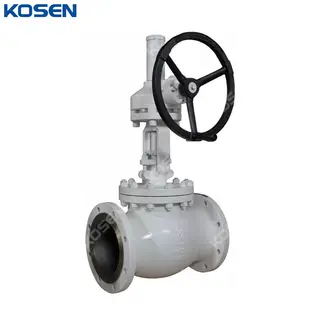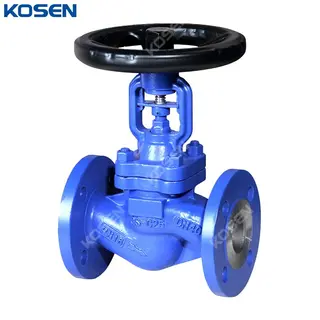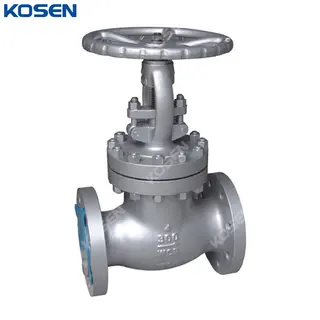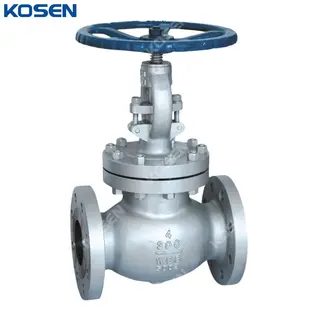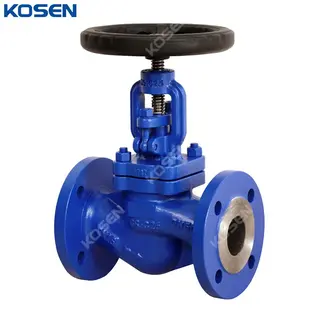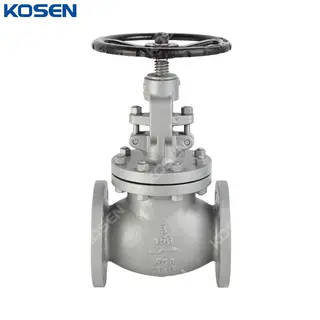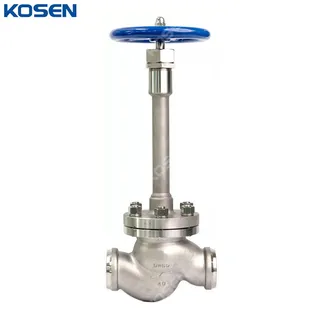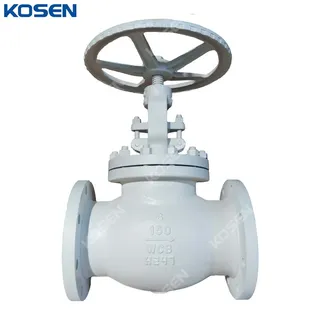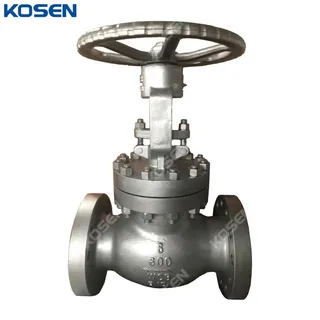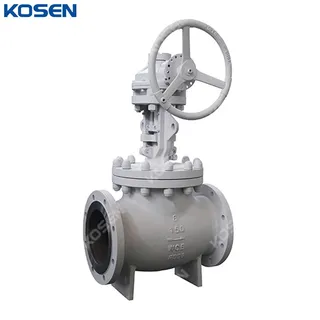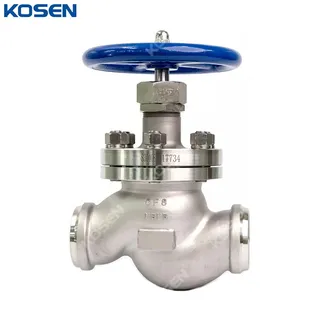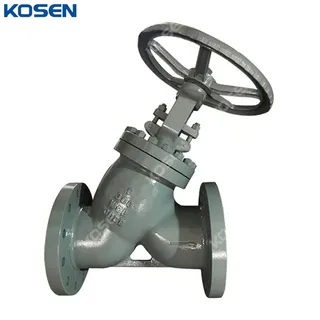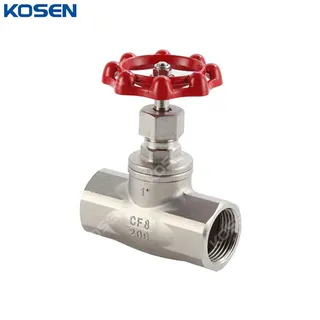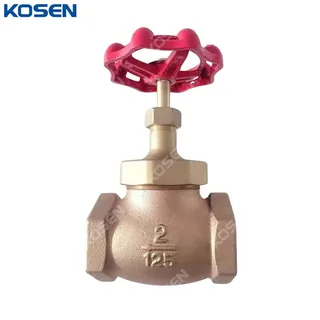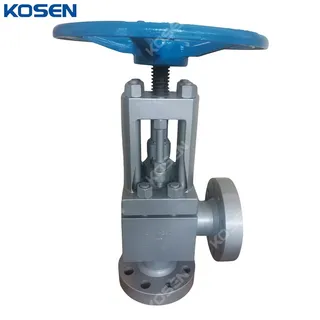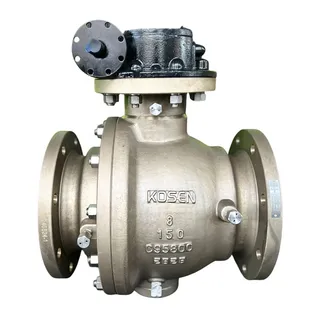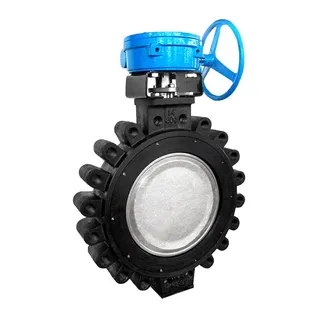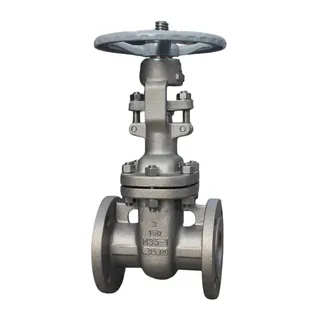The globe valve operates by applying torque through the valve stem to transfer pressure to the valve disc, ensuring that its sealing surface tightly contacts the valve seat, thereby preventing the flow of the medium or regulating its flow rate. The valve's opening and closing component is a plunger-type valve disc, which can have either a flat or conical sealing surface. The valve disc moves linearly along the flow centerline. Globe valve stems typically come in two designs: the rising stem type (where the stem rises while the handwheel remains fixed) and the rising and rotating stem type (where both the stem and handwheel rotate together while the nut is fixed to the valve body).
A globe valve is a forced sealing type valve, which means that in the closed state, external force is applied to the valve disc to ensure a tight seal between the sealing surfaces, preventing medium leakage. The opening and closing process is driven by the rotation of the handwheel, which raises or lowers the valve stem and causes the valve disc to move in a straight line, parallel to the flow direction of the medium. When the handwheel is rotated clockwise, the medium enters from the channel beneath the valve disc, and the sealing force must equal or exceed the sum of the pressure acting on the sealing surface and the force from the medium.
During the opening process, the flow rate reaches its maximum when the valve disc is raised to 25%-30% of the nominal diameter, which is considered the fully open position of the globe valve. Therefore, the fully open position of a globe valve is determined by the travel of the valve disc. Globe valves play a crucial role in cutoff and throttling applications. As a critical cutoff valve, its sealing pair consists of the valve disc and valve seat. The valve stem moves axially, driving the valve disc along the centerline to form an effective seal.
Globe valves are commonly used to control fluid flow and can be categorized based on their structure and working principle. The main types include straight-through globe valves, angle globe valves, and plunger-type globe valves. Below are their features and applications:
Also known as the Y-pattern globe valve, this type features a body design where the fluid passage forms an angle with the main flow path. This structure reduces flow disruption and results in lower pressure loss compared to traditional globe valves, effectively reducing energy loss during fluid flow. Therefore, straight-through globe valves are suitable for applications where low pressure loss is essential, improving system efficiency.
The unique feature of the angle globe valve is that the fluid changes direction only once as it passes through the valve. Compared to conventional globe valves, this design results in a smaller pressure drop, effectively reducing energy loss and pressure reduction. This valve is especially suited for applications where minimizing pressure drop is crucial, improving the overall efficiency of the system while ensuring effective flow control.
A plunger-type globe valve is an improved version of the traditional globe valve, designed based on the plunger principle. The valve disc and valve seat are connected in a plunger form, with the plunger precisely machined and connected to the valve stem. Two elastic sealing rings are fitted onto the plunger, and the sealing is achieved through the compression of the rings by a load applied from the valve cover nut. These sealing rings are replaceable, with various materials available for selection depending on the application. In addition to the standard opening and closing function, specialized plungers or rings can also allow for flow regulation. This type of valve is suitable for applications requiring tight sealing, offering flexibility and durability.
Globe valves consist mainly of the valve body, valve bonnet, valve disc, valve stem, handwheel, and sealing components. Each part plays a critical role in ensuring the proper operation and sealing performance of the valve.
Valve Body: The valve body is the main component of the globe valve, usually made of cast steel or forged steel, offering sufficient strength and excellent sealing capabilities. The body has internal fluid passages that allow the fluid to enter and exit the valve.
Valve Bonnet: The valve bonnet closes the top of the valve body and ensures the internal sealing performance. It is typically bolted to the valve body to prevent fluid leakage and contributes to the structural stability of the valve.
Valve Disc: The valve disc is the most critical component of the globe valve, controlling the fluid flow. It is typically made from wear-resistant, corrosion-resistant materials like stainless steel or special alloys. The valve disc forms a tight seal with the valve seat when closed to prevent leakage.
Valve Stem: The valve stem connects the valve disc to the handwheel and operates the valve disc by rotating. It is typically made of stainless steel to provide excellent corrosion resistance and strength, ensuring reliable operation over time.
Handwheel: The handwheel is the manual operating device for the globe valve. By rotating the handwheel, the valve stem is driven to control the opening and closing of the valve disc. Electric, pneumatic, or hydraulic actuators can be used for larger globe valves or for remote operation.
Sealing Components: To ensure good sealing performance, globe valves typically use sealing components such as gaskets and O-rings between the valve disc and seat, and between the valve stem and bonnet. These components are made from wear-resistant, corrosion-resistant materials to ensure stable performance over long-term use.
Due to their excellent flow control capabilities and reliability, globe valves are widely used in various industrial fields. Their primary function is to control the flow of liquids, gases, and steam, ensuring smooth process operations.
Industrial Applications: Globe valves play a critical role in industrial pipeline systems, especially in chemical and pharmaceutical plants, where they control the flow of various chemicals, liquids, and gases. Their durability and reliability ensure safe and stable production processes, making them essential components in industrial equipment.
Building Applications: In the construction industry, globe valves are widely used in water supply and drainage systems to control the flow of water. They ensure the proper operation of internal water supply and drainage systems. Additionally, globe valves are used in fire protection systems to cut off water sources in case of fire, preventing the spread of flames.
Energy Sector: Globe valves are crucial in the energy industry, particularly in power plants and petrochemical facilities, where they control the flow of liquids and gases, ensuring safe and efficient energy production and transportation. For example, in oil pipeline systems, globe valves control the flow of crude oil and can quickly shut off supply as needed, ensuring operational flexibility and safety.
Wastewater Treatment: In wastewater treatment plants, globe valves regulate the flow of wastewater and adjust pressure during the treatment process. They ensure that wastewater flows along the designated path, preventing leakage and environmental pollution.
When selecting a globe valve, several factors must be considered to ensure its performance, adaptability, and long-term reliability. Key points to consider include:
Globe valves use forced sealing, requiring adequate pressure to be applied to the valve disc when closed to prevent leakage. Unlike gate valves, the sealing force in a globe valve is aligned with the medium pressure but in the opposite direction, making the sealing force requirements higher.
Globe valves with flat sealing rings are not suitable for dirty or solid-containing media. For such media, valves with conical sealing surfaces should be chosen to ensure sealing performance and extend valve life.
For throttling, regulation, and high-pressure pipeline systems, globe valves are recommended for precise flow control. They are also suitable for low-pressure, compact, low-temperature, or high-temperature applications. However, they are not ideal for sludge, media containing solid particles, or quick opening/closing situations.
Some globe valves feature a bellows seal, which is more effective for handling flammable, explosive, toxic, or pure media and meeting vacuum system requirements. The bellows seal provides superior sealing, preventing leakage compared to traditional packing seals.
The design of a globe valve causes significant pressure loss due to the multi-directional flow changes inside the valve body. In hydraulic systems, this pressure loss can affect the overall efficiency of the system, so it should be minimized during the design process.
Proper installation of a globe valve is crucial for ensuring its long-term stable operation. Below are the key requirements to follow when installing a globe valve.
Pipeline System Preparation: Before installing the globe valve, ensure that the pipeline system's pressure is fully released and that any other valves connected to the globe valve are closed. Also, prepare the necessary tools and materials, such as wrenches and sealing compounds.
Choosing the Right Location: The globe valve should be installed in an appropriate location based on the requirements of the pipeline system. Generally, globe valves can be installed on horizontal or vertical pipelines, ensuring ease of operation and routine maintenance.
Cleaning the Pipeline: Prior to installation, ensure that the interior of the pipeline is clean, free of debris, and dirt to prevent any negative impact on the valve's normal operation and sealing performance.
Connection and Tightening: Place the globe valve in the installation position and use a wrench to tighten the threaded connection counterclockwise, ensuring a secure connection to prevent leakage. During the connection, use the appropriate sealing compound to ensure that the connection is tight and well-sealed.
Adjusting Valve Operation: After installation, check and properly adjust the opening and closing of the globe valve to ensure smooth operation. The valve disc should be installed facing upward to ensure proper alignment and reduce wear.
Flow Direction: When installing a globe valve, pay attention to the direction of flow. Typically, fluid in the pipeline should flow into the valve from below and out through the valve port, commonly referred to as "low in, high out." Avoid reverse installation.
Ensuring Sufficient Space for Operation: Choose an easily accessible installation location, ensuring enough space for operation and maintenance. For straight-through globe valves, the valve stem should be installed vertically to prevent sediment buildup inside the valve.
Pipeline Support and Stress Control: Ensure that the pipeline system provides adequate support to reduce stress on the valve body and prevent leaks or damage due to misalignment.
Selecting the Appropriate Seals: Use gaskets or seals compatible with the fluid and operating conditions to ensure leak-free connections between the valve and flanges, ensuring reliable sealing performance.
Actuator Alignment: If using an actuator to control the valve, ensure that the actuator is properly aligned with the valve stem to prevent the application of inappropriate stress or damage to the valve components.
Globe valves are widely used in industrial fluid control systems, favored for their excellent flow control capabilities and reliable sealing performance. However, globe valves also have some limitations, especially in certain special operating conditions. Below are the main advantages and disadvantages of globe valves.
Precise Fluid Control: Globe valves offer excellent fluid control capabilities, enabling precise regulation of fluid flow. By adjusting the valve opening, they can quickly start or stop fluid flow, controlling both flow rate and speed. This precise control makes globe valves widely applicable in various industrial uses.
Excellent Sealing Performance: Globe valves feature a well-designed sealing structure that effectively prevents fluid leakage, particularly maintaining excellent sealing performance in high-pressure and high-temperature environments. This reliable sealing capability makes globe valves the preferred choice in many critical industrial applications, preventing fluid leakage from affecting processes and equipment.
Simple Structure and Maintenance: The globe valve's structure is relatively simple, consisting of few parts, making installation and maintenance easy. When repairs or replacements are needed, disassembly and reassembly can be done quickly, reducing downtime and maintenance costs. Regular cleaning and lubrication are sufficient to keep the valve running smoothly.
Corrosion Resistance: Globe valves are typically made from corrosion-resistant materials, allowing them to operate for extended periods in corrosive media without damage. They are widely used in industries such as chemicals, petroleum, and pharmaceuticals. This corrosion resistance not only extends the valve's lifespan but also ensures the safety and reliability of the fluid control system.
High Fluid Resistance: The design of globe valves creates significant resistance to fluid flow, which may affect flow rates, particularly in applications requiring high flow. This can result in lower energy efficiency.
High Operating Force: Opening and closing a globe valve requires significant force, increasing operational difficulty and energy consumption, especially in larger valves.
Not Suitable for Particulate or High-Viscosity Fluids: Globe valves are not ideal for fluids containing particles, those with high viscosity, or those prone to solidifying. These fluids can block the valve seat or cause wear on the valve, affecting its normal operation.
Poor Flow Control Characteristics: Globe valves have relatively poor flow control characteristics, especially in cases requiring precise flow regulation. They may not be as effective as specialized control devices like regulating valves.
Despite their widespread use in pipeline systems, globe valves can face certain issues in practice. Below are some common problems and solutions:
Valve Leakage: Leakage is a common issue, typically caused by worn, loose, or damaged sealing elements. Regularly inspect sealing components and replace or repair them when issues are detected.
Valve Blockage: Blockages are often caused by debris or solid particles in the pipeline. Clean the pipeline and inspect the valve for any obstructions. If necessary, replace the valve.
Valve Failure to Open or Close Properly: This problem may occur due to improper operation, damaged valve components, or accumulated dirt. Adjust the operation method or replace damaged parts to resolve the issue.
Valve Leakage: Leakage typically results from poor sealing or damaged valve stem seals. This can be fixed by replacing sealing elements or adjusting valve components.
Valve Jamming: Bending of the valve core, damaged valve seat, or other mechanical issues can cause the valve to jam. Inspect the valve core and seat, and repair or replace parts as needed.
Internal Valve Leakage: Internal leakage is often caused by worn, aged, cracked, or improperly installed seals. Regularly inspect sealing components to ensure proper installation and replace aging or damaged seals in time.
Maintenance and Care of Globe Valves
As an essential component in pipeline systems, regular maintenance and care of globe valves are vital for ensuring their proper operation, improving efficiency, and extending their service life. Below are some key maintenance recommendations:
Appearance Inspection: Regularly inspect the valve's exterior, including the valve body and bonnet, to ensure there are no cracks, damage, or corrosion. Appearance checks are the first step in preventing potential failures.
Cleaning: Clean the internal and external surfaces of the valve, removing dust, grease, and other impurities. Use non-corrosive cleaning agents and soft cloths, avoiding harmful chemicals.
Sealing Performance Check: Inspect the valve's sealing surfaces to ensure no wear, scratches, or leakage. If any sealing issues are found, replace the sealing materials to ensure the valve's sealing performance.
Operational Check: Check the valve's operation, ensuring smooth opening and closing, clear indicator marks, and proper manual operation. Add lubricating oil as needed or make adjustments to ensure smooth operation.
Pipeline Connection Inspection: Regularly check the valve's pipeline connections to ensure no looseness or leakage. If problems are found, tighten the connections or replace sealing components.
Pressure and Temperature Check: Regularly verify that the valve's operating pressure and temperature are within the design values. If these values exceed normal ranges, adjust or replace the valve to prevent damage.
Preventing Damage from Inactivity: If the valve is not in use for long periods, periodically perform operational exercises to prevent parts from rusting or becoming damaged due to inactivity.
In conclusion, globe valves are highly versatile and reliable components used to control fluid flow across a wide range of applications. Their precise regulation capabilities, coupled with their excellent sealing performance, make them indispensable in critical industrial systems. While they come with certain limitations, such as high fluid resistance and the need for careful maintenance, their benefits far outweigh these drawbacks in most cases.
